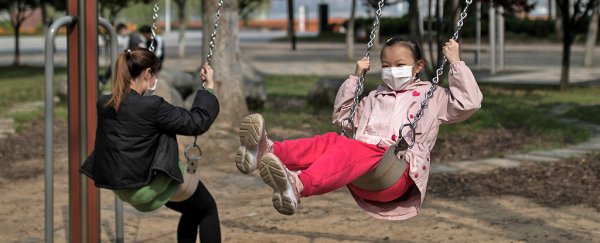The largest study yet of children with the new coronavirus provides very early evidence that males and infants may face increased risk of infection or severe illness.
The US Centres for Disease Control and Prevention released the study on Monday, which looked at more than 2,500 coronavirus cases among children younger than 18 in the US between February 12 and April 2. That's the largest research sample of children with the coronavirus to date.
Overall, the data suggested that children are less likely to develop coronavirus symptoms than adults. Of all reported cases in the US, only 1.7 percent were children, even though they make up 22 percent of the population.
Among the children for whom complete information was available, only 73 percent developed fever, cough, or shortness of breath. That's compared to 93 percent of adults reported in the same time frame, between the ages of 18 and 64 years.
That supports previous research from the Chinese CDC, which found that most infected children had mild or asymptomatic cases.
But some children do develop severe illness, and 147 of the patients in the new CDC study were hospitalized, with five sent to intensive care. Three children died.
US infants had a much higher hospitalisation rate than any other child age group. Of 95 infants, 62 percent were hospitalized. The estimated rate for children aged 1 to 17 was 14 percent at most.
"We do know that children's immune responses evolve over time," Dr. Yvonne Maldonado, chair of the committee on infectious diseases at the American Academy of Pediatrics, told Time. "The first year of life, children don't have the same robust immune response that older children and adults do."
Could 'biological factors' make males more susceptible to COVID-19?
A growing body of research has suggested that men are dying from COVID-19 at higher rates than women.
The World Health Organisation reported that as of March 20, men represented around 70 percent of coronavirus deaths in Western Europe.
Data from five countries with some of the world's largest outbreaks suggests that men are 50 percent more likely than women to die after a COVID-19 diagnosis, according to a March 20 analysis from CNN and the academic research group Global Health 50/50.
An analysis of more than 25,000 coronavirus cases from the Higher Health Institute of Rome found that male coronavirus patients in Italy had a fatality rate of 8 percent, compared to 5 percent for Italian women. The same analysis found that men represented a slight majority of Italy's coronavirus cases: around 58 percent.
Some experts have pointed out that men having higher rates of smoking, poorer hygiene on average, and higher rates of preexisting conditions like diabetes than women do.
But 57 percent of child COVID-19 patients in the CDC study were male. Even the infected infants were mostly male. That "suggests that biologic factors might play a role in any differences in COVID-19 susceptibility by sex," the study authors wrote.
Still, this research is preliminary and the authors are working with limited information. Among the 2,572 pediatric cases they analysed, only 9.4 percent included information on the patients' symptoms, and only 33 percent indicated whether or not they had been hospitalized.
The study authors recommended that doctors maintain "a high index of suspicion" for children who could have COVID-19, especially for infants and kids with underlying conditions.
"We have to be very careful overall," Maldonado told Time. "We really don't know what we are dealing with here yet."
This article was originally published by Business Insider.
More from Business Insider:
